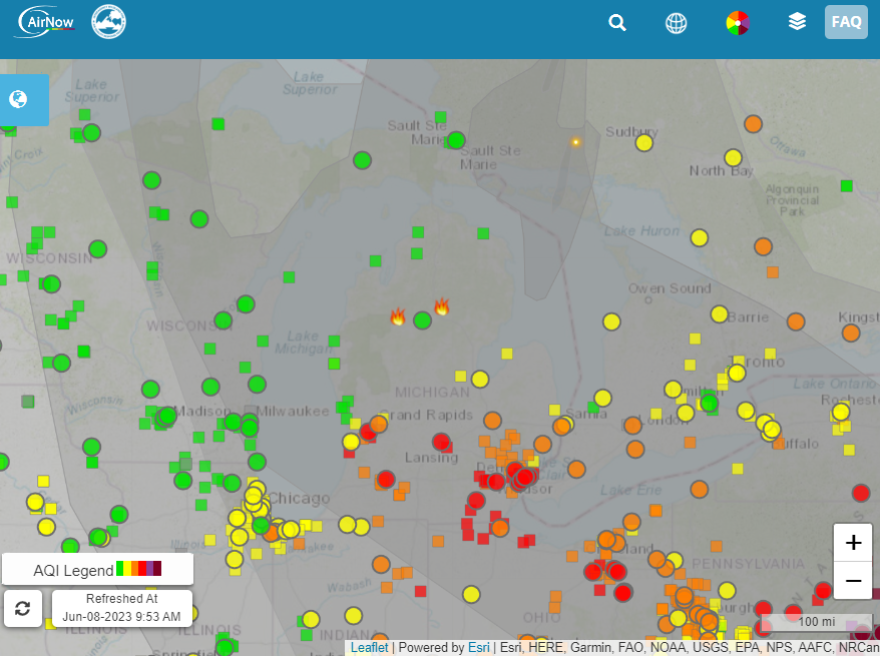If you’ve gotten air quality notifications this week, you're not alone. In fact, states outside of Michigan are struggling with air quality warnings, too. The smoke in Michigan originated from wildfires in Quebec, Canada, and weather patterns have carried the smoke and the haze down to the southeast side of the state.
We spoke with Sara Adar, associate professor of epidemiology at the University of Michigan School of Public Health, about air quality in the state. We’ve made a list of everything you need to know about air quality in Michigan, its effects, and what you should do if you get a bad air quality notification.
The high air quality index means that there are a lot of fine smoke particles in the air right now. The air particles are tiny — half the diameter of a human hair. When there’s an excess of those smoke particles in the air, it makes the air quality index go up.
The small smoke particles can travel deep into the lungs causing the body to have inflammation. Smoke particles can also stimulate nerves in the lungs, which can cause issues with blood pressure and heart rate. These smoke particles can even travel into the bloodstream and once they are in the bloodstream they can travel anywhere in the body, including the brain.
Strenuous exercise outdoors is not recommended. When exercising you are breathing more deeply, and the smoke particles can enter the lungs, which can take a toll on the body. If you have access to an indoor workout facility, or can do a workout from home, do that instead.
The levels of the fine particles are more densely packed than what the body is typically used to. Currently the air quality is reaching levels of around 100 micrograms per cubic meter. Typically, the daily ambient air quality standards are around 35 micrograms per cubic meter.
Who is at risk when there is a high air quality index warning?
Children, pregnant people, and individuals with pre-existing health, heart, or lung conditions.
Stay indoors and keep pets indoors as much as possible. If you have to be outdoors wearing a KN95 mask can help. Inside, using an air purifier, air conditioner, or a fan can also be beneficial.
Are the air quality issues from wildfires going to continue to be a problem?
While as a nation we have made strides to curb pollution from cars and trucks, wildfires are an issue that we are wrestling with and will continue to wrestle with for some time. Wildfires account for 25% to 50% of the yearly pollution in the West. Wildfire pollution has continued to increase yearly.
You can hear our full conversation with Sara Adar on the Stateside Podcast.
How can I track the air quality in my area?
There are several apps available that will give you up-to-date and detailed information about the air quality in whatever location you're in. All of these are available on iOS and Android:
Additionally, folks living on the West Coast with greater familiarity with wildfires reply on the PurpleAir map to see what air quality is like in their vicinity. The EPA also has its own AIRNow map to track air quality using information provided by citizen scientist air quality trackers as well as government-issued sensors.
How do I read an air quality index (AQI) value?
The EPA's AIRNow suggests thinking of the AQI as a yardstick that runs from 0 to 500. According to them, "the higher the AQI value, the greater the level of air pollution and the greater the health concern."
Here's a basic breakdown in handy chart-form from AIRNow:
Which areas of Michigan are being impacted most?
Looking at the EPA's AIRNow map, it looks like most of the areas in the red "unhealthy" area are in Southeast Michigan, but there is an unhealthy air quality level across the general lower half of the Lower Peninsula.

[Get Stateside on your phone: subscribe onApple Podcasts,Google Podcasts, orSpotify today.]
___
Looking for more conversations from Stateside?Right this way.
If you like what you hear on the pod, considersupporting our work.











